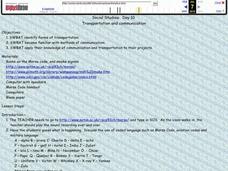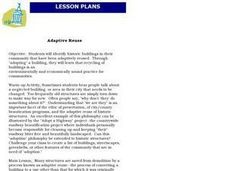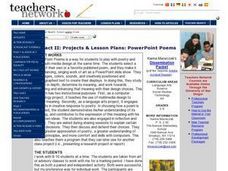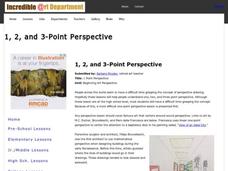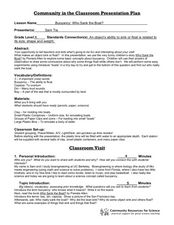West Virginia Department of Education
Editorials: The Guiding Voice of Authority?
How much can opinion influence a news story? A standalone resource discusses the importance of John Brown's Raid through the lens of journalism. Learners analyze two different texts, one from the perspective of the North and the other of...
Curated OER
An Incredible Journey: Exploring Brave New Worlds
High schoolers, after reading the novel, Brave New World, research in depth topics like the production and consumption of Henry Ford, Pavlov's and Skinner's behavioral science work, as well as the existence of Utopian and dystopian...
Curated OER
School Made Sampling Field Studies
Students explore the use of sounding lines and secchi disks. They construct
sounding lines to measure the depth of a water body and secchi disks to measure turbidity of water.
Curated OER
The Energy of Music
Students discover how engineers use sound energy. They participate in hands-on activities in which they discover how we know sound exists. They identify different pitches and frequencies as well.
Curated OER
Lesson Plan Three: Sense of Hearing and The Ear
Learners use their sense of hearing to observe sounds at school, label parts of the ear, and write their own version of the "Ears Hear" poem by following the example provided.
Curated OER
Exploring the Brass Family
Third graders explore the four basic instruments of the Brass Family in the four lessons of this unit. The French horn, trumpet, trombone, and tuba are inspected as students develope a familiarity with their sight and sounds.
Curated OER
The Language of Deception
Students examine how to distinguish between different uses of language. They explore the difference between the cognitive meaning and the emotional meanings of a word. Each student evaluates the effects of euphemism in altering the...
Curated OER
Transportation and Communication
Students take an in depth look at communication. In this communication lesson, students discuss the effectiveness of codes, languages, and transportation in communication. Students participate in a problem solving activity that requires...
Curated OER
Watching the Clock: An activity to build media-savvy students
Students analyze time constraints on broadcast news. They apply data collecting and data display skills. They identify the difference between news progams and the evening news.
Curated OER
Sea Secrets
Students study the following: For centuries, people have been challenged by the mysteries that lie beneath the blue depths of our ocean planet. Very little was known about the ocean until late in the nineteenth century, although nearly...
Curated OER
Adaptive Reuse
Students identify historic buildings in their community that have been adaptively reused. Through "adopting" a building, they will study how recycling of buildings is an environmentally and economically sound practice for communities.
Curated OER
PowerPoint Poems
Students identify how to play with poetry and create multi-media designs at the same time through PowerPoint. They select a poem of their own or a favorite published poem, and make it into a dancing, singing work of art as a PowerPoint...
Curated OER
Time for Technology
Ninth graders examine the role of technology in their lives. After viewing various photographs, they explain how technology has changed over time. In groups, they choose one technological advance and research it more in depth.
Curated OER
Rhythm and Improv, Jazz and Poetry
Connect the ideas of jazz improvisation and art to writing poetry. Learners collaborate and write different lines of poetry, imitating the jazz styles of improvisation and freewriting. Take a close look at the poems "Tenebrae" by Yusef...
Curated OER
Dyspraxia Presentation
Not really a resource for use in the classroom - this file is a PowerPoint presentation which gives information about Dyspraxia. It is a very interesting presentation because it shares many signs to look for in a person who may be...
Curated OER
Everyone Sang - Moods in Poetry
Start by reading the poem "Everyone Sang" by Siegried Sassoon. The archive also houses an audio clip, so consider playing that instead of reading it aloud. After hearing the poem twice, middle and high schoolers will discuss a list of...
Curated OER
Sculpture in Balance
Learners discuss the difference betwen two-dimensional vs. three-dimensional art. In this art lesson, students discuss what symmetry or balance is in art and construct a symmetrical and an asymmetrical mobile.
Rowland High School
The Catcher in the Rye Projects
What really knocks me out about this project list is that when you're done reading about the projects, you wish you could do them all. I'm not kidding. There are 16 terrific ideas and that doesn't happen very often.
Incredible Art
1, 2, and 3-Point Perspective
Introduce drawing high schoolers to perspective with a series of instructional activity that detail how to draft images in one-, two-, and three-point perspective. Each exercise includes step-by-step, illustrated directions and examples.
Curated OER
Buoyancy: Who Sank the Boat?
Students examine whether objects will sink or float. In this buoyancy instructional activity students bring in objects and experiment to see if they sink or float.
Curated OER
Native American Tribes
Have your class learn about Native American tribes in California. They identify five regions where Native Americans lived, discuss the daily life of these people, and conduct research on a particular tribe. Afterward, they create a...
Curated OER
Mapping The Ocean Floor
Young scholars explore and analyze the bottom structure of underwater habitats. They describe and explain what can't see through the collection and correlation of accurate data. Learners assess that technology is utilized as a tool for...
Curated OER
Wave Superposition: Interactive On-line Mac and PC
Students study definitions of wavelength, wave speed, wave amplitude, and wave period using an interactive JAVA environment. Distance and time are given so speed=wavelength/period can be verified or deduced by students. Waves reflection...
Curated OER
One World Ocean
Learners compare and contrast the properties of salt water in the oceans/seas and freshwater elsewhere on the planet. They also analyze mixing caused by currents in the ocean, including the effects of warm and cold water as well as with...









